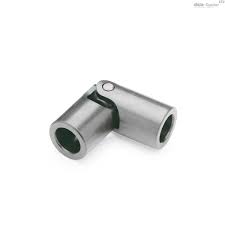Universal joints (UJ), also known as U-joints or cardan joints, are critical components in various mechanical systems, offering the ability to transmit rotary motion between shafts that are not aligned. They allow for the transfer of power in machinery, vehicles, and equipment with non-parallel shafts, ensuring smooth operation even when components are at angles to each other. As we look ahead to 2025, advancements in universal joint technology continue to improve the performance, durability, and reliability of these essential parts, making them indispensable for a range of industries, from automotive to industrial machinery.
What is a Universal Joint?
A universal joint is a mechanical device used to transmit torque and rotational motion between two shafts that are not in line with each other. These joints are typically used to connect rotating components in automobiles, trucks, industrial machinery, and other mechanical systems. The most common design of a universal joint consists of a cross-shaped component with bearings at each of the four ends, which allow it to rotate smoothly and efficiently while maintaining flexibility.
Universal joints are designed to compensate for the misalignment between shafts and can accommodate angular changes without affecting the smooth transmission of power. This is why they are commonly used in drive shafts, power tools, and various mechanical assemblies.
Key Features to Consider in Universal Joints
When selecting a universal joint, there are several key features to consider to ensure the best performance and durability for your specific application:
- Material Quality: Universal joints are typically made from steel, though more advanced models use high-strength alloys or materials like stainless steel for enhanced durability and corrosion resistance. The choice of material impacts the joint’s resistance to wear, its load-bearing capacity, and its longevity in harsh environments.
- Load Capacity: Universal joints are available in various sizes and load capacities. Selecting a universal joint with an appropriate load rating is crucial, as using one that cannot handle the required torque may lead to premature wear or failure.
- Angle of Operation: The range of angular movement that a universal joint can accommodate is essential for many applications. Most joints allow for an angle between the shafts of up to 45 degrees, though specialized designs can support higher angles. Choosing the right angle range is critical for ensuring the joint operates efficiently without excessive friction or strain.
- Lubrication: Universal joints require regular lubrication to ensure smooth operation and to reduce wear and tear on the internal components. Some joints come with sealed or greased fittings to help extend their lifespan, while others require periodic maintenance to ensure optimal performance.
- Size and Fit: The size and fit of a universal joint are also vital factors. A joint that is too large or too small for the application can cause inefficient operation or even damage to connected parts. It is essential to match the universal joint to the specific requirements of the machinery or vehicle.
Top Universal Joints for 2025
Several manufacturers and designs stand out as the top choices for universal joints in 2025, offering improved performance, durability, and ease of maintenance. Below are some of the leading universal joints that continue to be popular choices for a range of applications:
1. Neapco Heavy-Duty Universal Joints
Neapco is a well-respected name in the automotive and industrial markets, and their heavy-duty universal joints are widely used in both light-duty and heavy-duty applications. These joints are engineered with precision to offer high torque capabilities and are designed to withstand high-stress environments, making them ideal for use in trucks, off-road vehicles, and agricultural machinery. Neapco’s heavy-duty universal joints feature high-strength alloy steel, ensuring durability and longevity even under harsh conditions.
2. Spicer Life Series Universal Joints
Spicer is another top manufacturer known for its robust universal joints, particularly in the automotive and commercial vehicle sectors. The Spicer Life Series universal joints are built to handle extreme angles and high rotational speeds, making them perfect for vehicles that operate in demanding conditions. These joints are designed with premium materials and advanced sealing technologies, ensuring maximum performance and reduced maintenance requirements. The Spicer Life Series is a preferred choice for many heavy-duty truck and off-road vehicle owners.
3. Dana Spicer® U-Joints
Dana, the parent company of Spicer, produces high-performance universal joints that are widely used in the automotive, industrial, and agricultural sectors. The Dana Spicer U-joints are designed for high-torque applications, and their construction allows them to function smoothly even in challenging environments with significant shaft misalignment. They are built to last, featuring durable components and a reputation for reliability, making them a popular choice for both light and heavy-duty applications.
4. Meritor U-Joints
Meritor is another industry leader that offers a wide range of universal joints designed for commercial vehicles, heavy machinery, and industrial applications. Their universal joints are known for their strength, reliability, and precision. Meritor’s U-joints are engineered with high-quality materials to handle demanding tasks, offering long-lasting performance even in the toughest environments. They are frequently used in trucks, trailers, and off-road equipment, where durability and consistent performance are key.
5. GKN Driveline Universal Joints
GKN Driveline offers advanced universal joints that provide smooth torque transmission while minimizing friction and wear. These universal joints are commonly used in automotive drive shafts, particularly in high-performance vehicles. GKN’s U-joints are designed to offer excellent angular movement and torsional flexibility, making them ideal for applications where both precision and durability are essential. The company’s focus on innovation ensures that their universal joints continue to lead the market in terms of performance.
Benefits of Using High-Quality Universal Joints
- Enhanced Durability: High-quality universal joints, such as those made with alloy steels or high-strength materials, are built to last longer and endure more rigorous usage than lower-grade alternatives. This reduces the frequency of repairs and replacements, saving money in the long run.
- Improved Performance: Universal joints play a critical role in maintaining smooth operation and transferring power efficiently between shafts. A well-designed U-joint ensures that torque is transmitted smoothly, even when there are misalignments between connected shafts.
- Reduced Maintenance: Premium universal joints are designed with features such as sealed bearings, lubrication grooves, and durable seals, which reduce the need for frequent maintenance and lubrication.
- Increased Flexibility: Universal joints allow for angular movement between shafts, enabling machinery and vehicles to maintain performance even when components are not perfectly aligned. This flexibility is critical in environments where shafts are subjected to varying angles during operation.
- Cost-Effectiveness: Investing in a high-quality universal joint can reduce overall maintenance costs, downtime, and the need for frequent replacements, making them a cost-effective solution for long-term use.
Conclusion
As industries continue to evolve, the demand for reliable and durable universal joints increases. In 2025, choosing the right universal joint is essential to ensuring the efficient operation of various mechanical systems. Whether you’re in the automotive, industrial, or agricultural sector, investing in top-tier universal joints can improve the longevity and performance of your machinery or vehicle. By considering key features such as material quality, load capacity, and angle of operation, you can select a universal joint that best meets the needs of your specific application.














